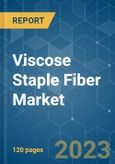The COVID-19 pandemic has significantly impacted the value chain in every aspect. Because of the government's limitations, the supply of raw materials came to a standstill. As a result of the lockdowns in several countries, viscose fiber prices have dropped, forcing many companies, such as Lenzing AG, to start making safety masks at their factories, as non-woven fibers are needed for mask manufacturing. The pandemic had a detrimental influence on the market, particularly in automobile and garment applications. However, the industry saw marginal growth in 2021, as several firms have begun to produce woven textiles in their facilities. In the scheduled time, the market is expected to grow positively.
Key Highlights
- In the short term, the market will be driven by the demand for viscose fiber from the fashion apparel sector.
- Synthetic fibers may hamper the market expansion of viscose fibers.
- Future market opportunities will arise from the growing usage of dense fibers in the medical sector.
- The Asia-Pacific region dominated the market and is also estimated to record the fastest CAGR during the forecast period.
Viscose Staple Fibre Market Trends
Increasing Demand for Woven Fibers
- Natural and biodegradable viscose staple fibers (VSF) or artificial cotton fibers are made from wood pulp and cotton pulp, both of which have properties similar to cotton fibers. These fibers are adaptable and pliable and may be used in various applications, including garments, home textiles, home furnishings, dress materials, and woven and knitted.
- Increasing demand for textiles and apparel is expected to drive the demand for VSF in these applications. Asia-Pacific, the largest market for woven fabrics, is witnessing healthy growth due to the increasing demand in countries like India, China, etc.
- In India, the demand for apparel has increased with growing consumer preference in response to growing foreign textile brands. The demand has been augmented by digitalization and social networking sites and apps, which help increase garments sales. Indian apparel exports to United States climbed by 38.5% in 2021 to a total of USD 209.63 million, according to The International Trade Administration of the U.S. Department of Commerce.
- Viscose is the most critical artificial cellulose fiber, with a market share of around 79% of all man-made cellulose fibers.
- Small regions, such as Bangladesh, have witnessed an increase in population and living standards, driving the demand for knitted fabrics.
- All the factors above are expected to increase the demand for viscose staple fiber during the forecast period.
The Asia-Pacific Region is Expected to Dominate the Market
- Asia-Pacific is expected to dominate the VSF market during the forecast period owing to the rapidly increasing yarn production.. China is the largest producer and consumer of viscose staple fiber globally.
- China is the largest clothing producer in the world and has the largest production capacity for textile products consisting of cotton, man-made fibers, and silk. The major problem faced by the Chinese viscose staple fiber industry is the presence of surplus production capacities.
- Lenzing and Birla are some of the major global manufacturers with their production facilities in China.
- According to Invest India, in 2021, India's domestic clothing and textile sector provides 5% of the GDP, 7% of industrial production in value terms, and 12% of export revenues. India is the world's sixth-largest exporter of textiles and clothing.
- With the removal of Anti Dumping Duty on viscose fiber in India, the industry is set to see a growth surge in the coming years.
- There has been an increase in wages in the country due to which the textile production is expected to shift to low-wage ASEAN countries, ultimately affecting the sales of viscose staple fiber in China.
- Additionally, supportive government regulations, such as the Amended Technological Upgradation Fund Scheme (ATUFS) and the Scheme for Integrated Textile Parks (SITP), and capital and freight subsidy on textiles by the states of Maharashtra and Haryana have provided a boost to the industry. This, in turn, has significantly driven the market for viscose staple fiber in India.
- Due to all these factors, the market for viscose staple fiber is expected to grow in the region during the forecast period.
Viscose Staple Fibre Industry Overview
The viscose staple fiber market is consolidated, and the top five manufacturers occupy around 60% of the market. The major players in the market include Lenzing AG, Birla Cellulose, SATERI, Xinjiang Zhongtai Chemical Co. Ltd, and Tangshan Sanyou Group Xingda Chemical Fibre Co. Ltd, among others.Additional Benefits:
- The market estimate (ME) sheet in Excel format
- 3 months of analyst support
This product will be delivered within 2 business days.
Table of Contents
Companies Mentioned (Partial List)
A selection of companies mentioned in this report includes, but is not limited to:
- Asia Pacific Rayon Limited
- Birla Cellulose
- Glanzstoff
- Jilin Chemical Fiber Group Co. Ltd
- Kelheim Fibres GmbH
- LENZING AG
- Nanjing Chemical Fibre Co. Ltd
- Sateri
- SNIACE Group
- Tangshan Sanyou Group Xingda Chemical Fibre Co. Ltd
- Yibin Hiest Fibre Limited Corporation (Milan)
- Xinjiang Zhongtoi Chemical Co. Ltd








